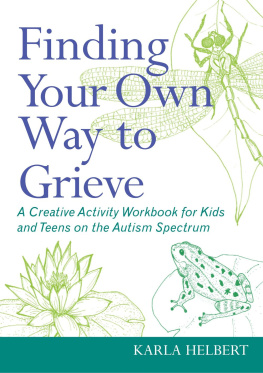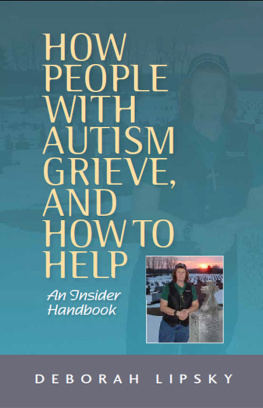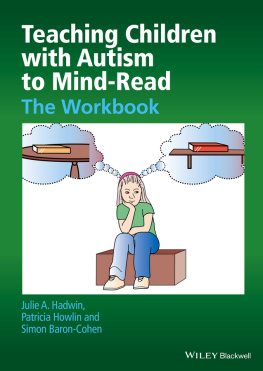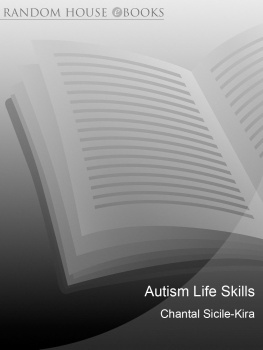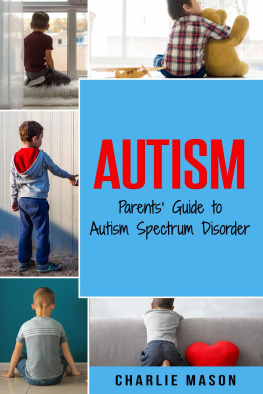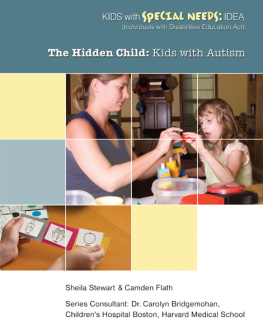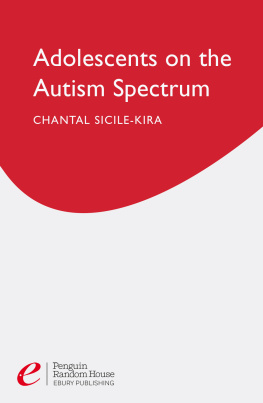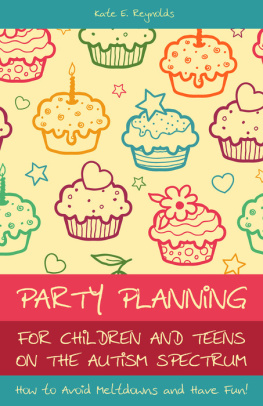Finding
Your Own
Way to
Grieve
A Creative Activity Workbook for Kids and Teens on the Autism Spectrum
KARLA HELBERT

Jessica Kingsley Publishers
London and Philadelphia
Acknowledgements
This book would not have been possible without a great deal of help and support from innumerable people. I am unable to mention every person whose help and presence in my life, education, and career has contributed not only to the conception, writing, and completion of this project, but to who I am as a person. That would take a whole book in itself. Since I have this platform, however, I would like to take a moment to mention some of those to whom it is possible to give specific mention. First, I want to thank my husband Jamie Fueglein, who has been a pillar of support to me, not only throughout completion of this book, but in my life overall. Meeting you was a Midsummer Nights Dream come true. Thank you for your love and your patience. His awesome editing talents also contributed greatly to the finished text.
The support and love of my parents has always been a constant for which I am eternally grateful. Thank you both. To my extended family and my friends, those who have been there for us through the darkest of days, before and after, for your deep love, your heartfelt support, your big shoulders and your listening ears, thank you. I could never ask for more supportive, loving people in my life. I am so lucky to have you.
I would never have had cause to write this particular book without those who were instrumental in helping me become who I am as a therapist. I wish to thank Grafton School, Inc. for existing. I am grateful for the amazing people I worked with and learned from during my years there, and most of all for my clients, who taught me that autism is a word that means we may be different, but we are also the same. The children, teenagers and adults I worked with early on in my career shaped who I am today and, most important of all, helped me to see the world in a different and better way. I will always be grateful for my experiences with you.
I am grateful to my bright and talented clients, Ashley Morris and Bentley Mescall, who contributed their artwork to this book. It is a privilege to know you both. Thank you for allowing me to be part of your journey and for sharing this part of yourselves with others.
Thank you to Dick Blick Art Materials for generous permission to use the beautiful Japanese lantern lesson plans. Its one of my favorite projects in the book.
Thank you to Jessica Kingsley Publishers for taking this book on and helping to fill a need where there is a great one to be filled.
Were it not for my own grief journey, this book would not exist. I will never be grateful for the absence of my child in my life. His not being here hurts every day. No matter how its framed up, I refuse to be grateful for my grief, but I am so grateful for those who have been there from the beginning and for those whom I found along the way. To other bereaved parents, no one knows like you know. I wish things were different for us all, but I am ever grateful for your unmatched understanding.
This list of acknowledgements would be sorely incomplete without mention of my son Theo. Without the fact of the illness that took his life, and which changed me and my family forever, I know I would never have written this book. Since his death, I have an intimate understanding of what Alice meant when she came upon the Caterpillar in Wonderland and he asked, Who are you? Alice replied, I hardly know, sir. I know who I was, but I think I mustve changed. Yes. Grief changes us, that surely must be acknowledged, but it doesnt have to stop us from living our lives wholeheartedly, and it can never, ever stop love.
Love is stronger than death.
The Toro Nagashi activity, on pp. 12129, was gratefully adapted from Dick Blick Art Materials Japanese Floating Lanterns Lesson.
, on p. 66, has been reproduced with kind permission from Ashley Morris.
, on p. 108, has been printed with kind permission from Bentley Mescall.
First published in 2013
by Jessica Kingsley Publishers
116 Pentonville Road
London N1 9JB, UK
and
400 Market Street, Suite 400
Philadelphia, PA 19106, USA
www.jkp.com
Copyright Karla Helbert 2013
Illustrations copyright Karla Helbert 2013
All rights reserved. No part of this publication may be reproduced in any material form (including photocopying or storing it in any medium by electronic means and whether or not transiently or incidentally to some other use of this publication) without the written permission of the copyright owner except in accordance with the provisions of the Copyright, Designs and Patents Act 1988 or under the terms of a licence issued by the Copyright Licensing Agency Ltd, Saffron House, 610 Kirby Street, London EC1N 8TS. Applications for the copyright owners written permission to reproduce any part of this publication should be addressed to the publisher.
Warning: The doing of an unauthorised act in relation to a copyright work may result in both a civil claim for damages and criminal prosecution.
Library of Congress Cataloging in Publication Data
A CIP catalog record for this book is available from the Library of Congress
British Library Cataloguing in Publication Data
Helbert, Karla.
Finding your own way to grieve : a creative activity workbook for kids and teens on the autism
spectrum / Karla Helbert.
p. cm.
ISBN 978-1-84905-922-0 (alk. paper)
1. Grief in children. 2. Grief in adolescence. 3. Autistic children. 4. Autistic youth. I. Title.
BF723.G75H336 2013
155.9370874--dc23
2012035689
ISBN 978 1 84905 922 0
eISBN 978 0 85700 693 6
Printed and bound in Great Britain
Contents
Chapter 5 : Its Okay to Feel Sad, or Even Angry, When
Someone We Love Dies
Chapter 8 : We Can Always Remember the People We
Love Who Have Died
Choosing a Therapist
Choosing a counselor or therapist is a very personal decision. The most important element in a therapeutic relationship is the relationship itself. If you trust the therapist and feel safe with him or her, this is the number one consideration. This is true for the child as well as the parent.
When choosing a therapist, you should feel comfortable with that person. You should feel comfortable with how he or she interacts with your child. Your child should also feel comfortable with that person. This section may help you in your decision making when searching for a therapist.
A common question is, What is the difference between a counselor and a therapist? Often, the words therapy and counseling are used to mean the same thing. They are very similar, but do have differences. In the field of mental health, counseling usually refers to a brief treatment focusing on a specific problem (like grief), and the solving of that problem. The counselor will generally offer specific suggestions and advice to help the client deal with the problem.
In practice, with a mental health professional, there is usually some overlap between counseling and psychotherapy. Psychotherapy is the longer term that most people simply shorten to therapy. Often, unless a client comes in for counseling with a very specific concern (or the counselor/therapist specializes in brief treatment), other issues more appropriately addressed through psychotherapy often come up. Psychotherapy usually involves longer treatment of many overlapping issues or problems. It involves helping the client learn more about his or her internal motives and gain insight into his or her behavior through questioning and learning about motives, needs, behavior patterns, emotions, and more. I frequently have clients come in due to a specific need or problem and, through our work together, discover other issues they would like to work on that are better dealt with through more long-term therapy. In those cases, counseling, as well as psychotherapy, are conducted with the same client.
Next page
